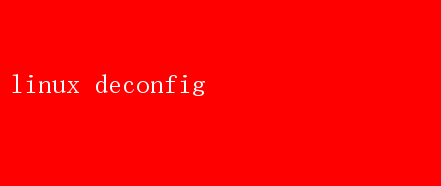
Linux Deconfig: Unlocking the Power of System Streamlining
In the vast landscape of operating systems, Linux stands as a towering figure, known for its versatility, robustness, and unparalleled customization capabilities. From humble beginnings as a free and open-source alternative to Unix, Linux has evolved into a cornerstone of modern computing, powering servers, desktops, mobile devices, and even supercomputers. However, with great power comes great responsibility—especially when it comes to managing and configuring a Linux system. One of the most critical, yet often overlooked, aspects of maintaining a Linux system is the process of deconfiguration or deconfig for short. This article delves into the intricacies of Linux deconfig, why its essential, and how it can unlock the true potential of your system.
Understanding Linux Deconfig: What is It?
At its core, Linux deconfig refers to the process of removing unnecessary configurations, services, and software from a Linux system. This is not to be confused with a simple uninstall or deletion; deconfig involves a meticulous analysis of the systems current state, identifying what is truly essential, and then systematically stripping away the excess. The goal is to streamline the system, reducing overhead, enhancing security, and improving overall performance.
Deconfig is often a multi-step process that includes:
1.Auditing Installed Packages: Identifying and removing software that is no longer needed or has been superseded by newer versions.
2.Disabling Unused Services: Stopping and disabling services that are not actively used, thereby freeing up system resources.
3.Optimizing Configurations: Tweaking system and application configurations to minimize resource consumption and maximize efficiency.
4.Cleaning Up Logs and TemporaryFiles: Removing old logs and temporary files to prevent disk space from being unnecessarily consumed.
5.Hardening Security: Removing potential attack vectors by disabling unnecessary network services and tightening permissions.
Why Deconfig is Essential
The importance of deconfig cannot be overstated. Here are several compelling reasons why every Linux administrator should prioritize this process:
1.Performance Optimization: By removing unnecessary software and services, you reduce the systems workload, leading to faster boot times, quicker application launches, and smoother overall operation.
2.Security Enhancement: Every service running on a system represents a potential entry point for attackers. By disabling unused services and tightening configurations, you significantly reduce the attack surface, making the system more secure.
3.Resource Management: In environments with limited resources, such as embedded systems or virtual machines, every bit of CPU, memory, and disk space counts. Deconfig helps ensure that these precious resources are used efficiently.
4.Compliance and Best Practices: Many industry standards and best practices recommend regular system audits and cleanups. Deconfig is a crucial part of this process, ensuring that the system adheres to these guidelines.
5.Simplified Maintenance: A leaner system is easier to manage and troubleshoot. With fewer components to monitor and fewer configurations to worry about, administrators can focus on more critical tasks.
Practical Steps to Linux Deconfig
Now that we understand the importance of deconfig, lets dive into the practical steps involved in performing this process.
1.Audit Installed Packages
Begin by listing all installed packages and identifying those that are no longer needed. Tools like`dpkg` (Debian-based systems) or`rpm` (Red Hat-basedsystems) can list installed packages. For a more comprehensive audit, considerusing `apt-rdepends` or`repoquery` to analyze package dependencies.
bash
Debian/Ubuntu example
dpkg -l | grep ^rc List installed but not-required packages
apt autoremove# Automatically remove them
CentOS/RHEL example
package-cleanup --leaves List orphaned packages
yum autoremoveAutomatically remove them
2.Disable Unused Services
Use tools like`systemctl`(for systemd-based systems) or`service` (for SysVinit-basedsystems) to manage services. Identify and disable services that are not required.
bash
List all services
systemctl list-units --type=service --all
Disable a service
systemctl disable
Stop a running service
systemctl stop
3.Optimize Configurations
Con
